Power electronic handbook
Подождите немного. Документ загружается.

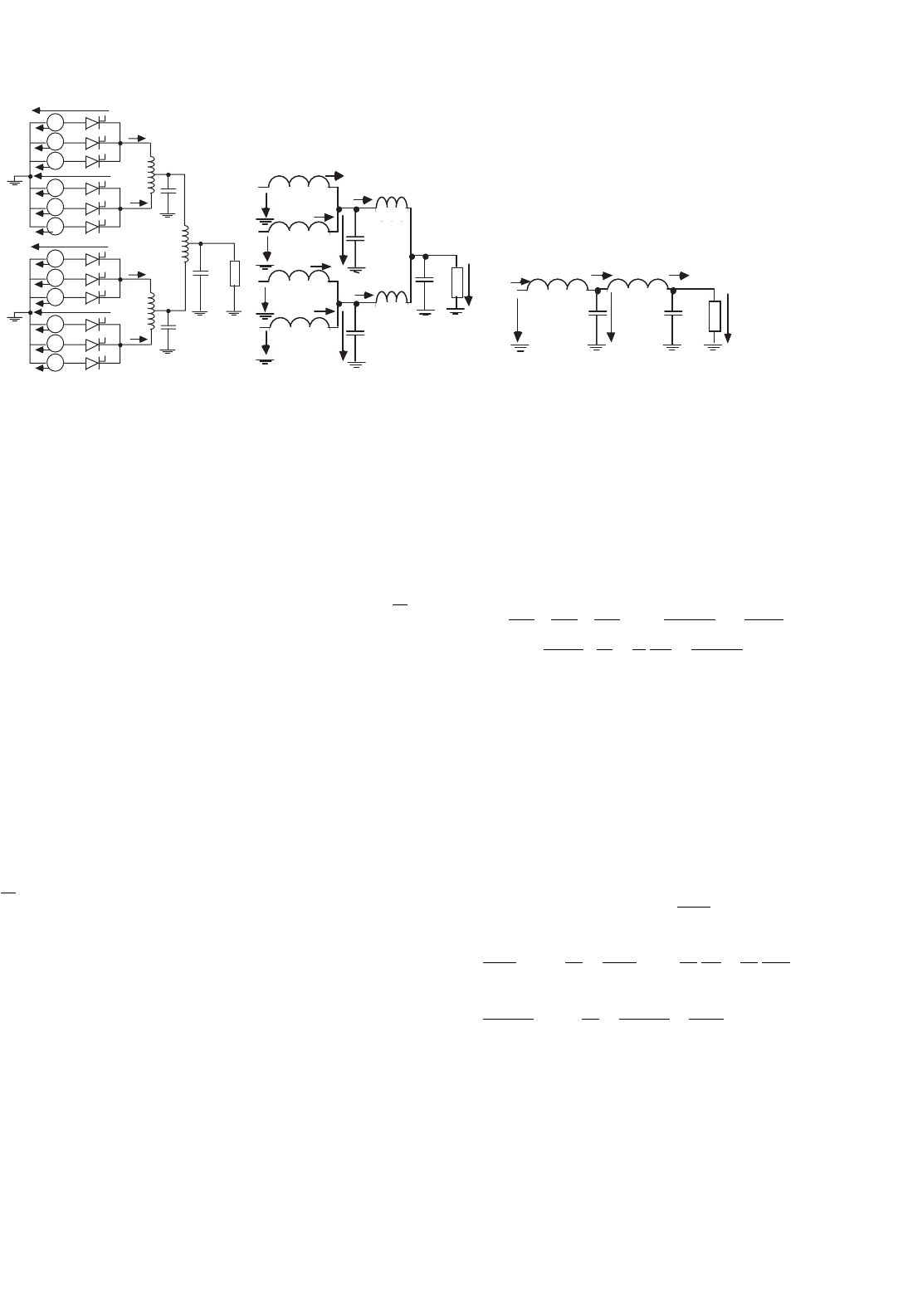
34 Control Methods for Switching Power Converters 967
C
2
l
i
l
1
i
l
2
i
l
3
i
l
4
l'
l
l
l
l'
C'
C'
v
i
2
v
i
3
v
i
4
v
i
1
E
3'
C
2
l
2
C
12
l
1
l
5
l
4
l
3
l
6
i
l
1
i
l
2
i
l
3
i
l
5
i
l
6
C
11
v
i
1
v
i
2
v
i
3
v
i
4
v
c
11
v
c
12
v
c
2
Load
Load
i
l
4
C
2
v
c
1
v
c
2
L
1
L
2
C
1
i
L
1
v
i
Load
i
o
i
L
2
(a) (b) (c)
E
1
E
2
E
3
E
1'
E
2'
E
4
E
5
E
6
E
4'
E
5'
E
6'
FIGURE 34.35 (a) 12-pulse rectifier with interphase reactors and intermediate capacitors; (b) rectifier model neglecting the half-wave rectifier
dynamics; and (c) low-order averaged equivalent circuit for the 12-pulse rectifier with the resulting output double LC filter.
obtain a second-order LC filter. This allows low-ripple output
voltage and continuous mode of operation (laboratory model
with l = 44 mH; l
= 13 mH; C
= C
2
= 10 mF; star-delta
connected ac sources with E
RMS
≈ 65 V and power rating
2.2 kW, load approximately resistive R
o
≈ 3–5 ).
To control the output voltage v
c
2
, given the complexity of
the whole system, the best approach is to derive a low-order
model. By averaging the four half-wave rectifiers, neglecting
the rectifier dynamics and mutual couplings, the equivalent
circuit of Fig. 34.35b is obtained (l
1
= l
2
= l
3
= l
4
= l;
l
5
= l
6
= l
; C
11
= C
12
= C
). Since the rectifiers are identical,
the equivalent 12-pulse rectifier model of Fig. 34.35c is derived,
simplifying the resulting parallel associations (L
1
= l/4; L
2
=
l
/2; C
1
= 2C
).
Considering the load current i
o
as an external perturba-
tion and v
i
the control input, the state-space model of the
equivalent circuit of Fig. 34.35c is
d
dt
i
L
1
i
L
2
v
c
1
v
c
2
=
00−1/L
1
0
001/L
2
−1/L
2
1/C
1
−1/C
1
00
01/C
2
00
i
L
1
i
L
2
v
c
1
v
c
2
+
1/L
1
0
00
00
0 −1/C
2
v
i
i
o
(34.117)
34.3.5.5 Sliding-mode Control of the 12-pulse Parallel
Rectifier
Since the output voltage v
c
2
of the system must follow the
reference v
c
2r
, the system equations in the phase canonical
(or controllability) form must be written, using the error
e
v
c
2
= v
c
2r
− v
c
2
and its time derivatives as new state error
variables, as done in Example 34.11.
d
dt
e
v
c
2
e
θ
e
γ
e
β
=
e
θ
e
γ
e
β
−
1
C
1
L
1
+
1
C
1
L
2
+
1
C
2
L
2
e
γ
−
e
v
c
2
C
1
L
1
C
2
L
2
−
1
C
1
L
1
C
2
+
1
C
1
C
2
L
2
di
o
dt
−
1
C
2
d
3
i
o
dt
3
−
v
i
C
1
L
1
C
2
L
2
(34.118)
The sliding surface S(e
x
i
, t), designed to reduce the system
order, is a linear combination of all the phase canonical state
variables. Considering Eqs. (34.118) and (34.117), and the
errors e
v
c
2
, e
θ
, e
γ
, and e
β
, the sliding surface can be expressed
as a combination of the rectifier currents, voltages, and their
time derivatives:
S(e
x
i
,t ) =e
v
c
2
+k
θ
e
θ
+k
γ
e
γ
+k
β
e
β
=v
c
2r
+k
θ
θ
r
+k
γ
γ
r
+k
β
β
r
−
1−
k
γ
C
2
L
2
v
c
2
−
k
γ
C
2
L
2
v
c
1
+
k
θ
C
2
−
k
β
C
2
2
L
2
i
o
+
k
γ
C
2
di
o
dt
+
k
β
C
2
d
2
i
o
dt
2
−
k
β
C
1
C
2
L
2
i
L
1
−
k
θ
C
2
−
k
β
C
1
C
2
L
2
−
k
β
C
2
2
L
2
i
L
2
=0
(34.119)
Equation (34.119) shows the variables to be measured (v
c
2
,
v
c
1
, i
o
, i
L
1
, and i
L
2
). Therefore, it can be concluded that the
output current of each three-phase half-wave rectifier must be
measured.

968 J. F. Silva and S. F. Pinto
The existence of the sliding mode implies S(e
x
i
, t) = 0 and
˙
S(e
x
i
, t) = 0. Given the state models (34.117, 34.118), and
from
˙
S(e
x
i
, t) = 0, the available voltage of the power supply
v
i
must exceed the equivalent average dc input voltage V
eq
(34.120), which should be applied at the filter input, in order
that the system state slides along the sliding surface (34.119).
V
eq
=
C
1
L
1
C
2
L
2
k
β
θ
r
+k
θ
γ
r
+k
γ
β
r
+k
β
˙
β
r
+v
c
2
−
C
1
L
1
C
2
L
2
k
β
×
θ +k
γ
β
+
C
2
L
2
+C
2
L
1
+C
1
L
1
−C
1
L
1
C
2
L
2
k
θ
k
β
γ
+
(
L
1
+L
2
)
di
o
dt
+C
1
L
1
L
2
d
3
i
o
dt
3
(34.120)
This means that the power supply root mean square (RMS)
voltage values should be chosen high enough to account for the
maximum effects of the perturbations. This is almost the same
criterion adopted when calculating the RMS voltage values
needed with linear controllers. However, as the V
eq
voltage
contains the derivatives of the reference voltage, the system
will not be able to stay in sliding mode with a step as the
reference.
The switching law would be derived, considering that,
from Eq. (34.118) b
e
(e) > 0. Therefore, from Eq. (34.97), if
S(e
x
i
, t) > +ε, then v
i
(t) = V
eq
max
, else if S(e
x
i
, t) < −ε,
then v
i
(t) =−V
eq
max
. However, because of the lack of gate
turn-off capability of the rectifier thyristors, power rectifiers
cannot generate the high-frequency switching voltage v
i
(t),
since the statistical mean delay time is T /2p(T = 20 ms)
and reaches T /2 when switching from +V
eq
max
to −V
eq
max
.
To control mains switched rectifiers, the described constant-
frequency sliding-mode operation method is used, in which
the sliding surface S(e
x
i
, t) instead of being compared to zero,
is compared to an auxiliary constant-frequency function r(t)
(Fig. 34.6b) synchronized with the mains frequency. The new
switching law is
If k
p
S(e
x
i
,t)> r(t )+ι ⇒Trigger the next thyristor
If k
p
S(e
x
i
,t)< r(t )−ι ⇒Do not trigger any
thyristor
⇒v
i
(t)
(34.121)
Since now S(e
x
i
, t) is not near zero, but around some value
of r(t ), a steady-state error e
v
c
2av
appears (min[r(t )]/k
p
<
e
v
c
2av
< max[r(t )]/k
p
), as seen in Example 34.11. Increasing the
value of k
p
(toward the ideal saturation control) does not over-
come this drawback, since oscillations would appear even for
moderate k
p
gains, because of the rectifier dynamics. Instead,
the sliding surface (34.122), based on Eq. (34.99), should be
used. It contains an integral term, which, given the canoni-
cal controllability form and the Routh–Hurwitz property, is
the only nonzero term at steady state, enabling the complete
elimination of the steady-state error.
S
i
(e
x
i
, t) =
e
v
c
2
dt +k
1v
e
v
c
2
+k
1θ
e
θ
+k
1γ
e
γ
+k
1β
e
β
(34.122)
To determine the k constants of Eq. (34.122) a pole-
placement technique is selected, according to a fourth-order
Bessel polynomial B
E
(s)
m
, m = 4, from Eq. (34.88), in order to
obtain the smallest possible response time with almost no over-
shoot. For a delay characteristic as flat as possible, the delay
t
r
is taken inversely proportional to a frequency f
ci
just below
the lowest cutoff frequency (f
ci
< 8.44 Hz) of the double LC
filter. For this fourth-order filter, the delay is t
r
= 2.8/(2πf
ci
).
By choosing f
ci
= 7Hz (t
r
≈ 64 ms), and dividing all the
Bessel polynomial terms by st
r
, the characteristic polynomial
(34.123) is obtained:
S
i
(e
x
i
, s) =
1
st
r
+1 +
45
105
st
r
+
10
105
s
2
t
2
r
+
1
105
s
3
t
3
r
(34.123)
This polynomial must be applied to Eq. (34.122) to obtain
the four sliding functions needed to derive the thyristor trig-
ger pulses of the four three-phase half-wave rectifiers. These
sliding functions will enable the control of the output current
(i
l
1
, i
l
2
, i
l
3
, and i
l
4
) of each half-wave rectifier, improving the
current sharing among them (Fig. 34.35b). Supposing equal
current share, the relation between the i
L
1
current and the
output currents of each threephase rectifier is i
L
1
= 4i
l
1
=
4i
l
2
= 4i
l
3
= 4i
l
4
. Therefore, for the nth half-wave three-phase
rectifier, since for n = 1 and n = 2, v
c
1
= v
c
11
and i
L
2
= 2i
l
5
and for n = 3 and n = 4, v
c
1
= v
c
12
and i
L
2
= 2i
l
6
, the four
sliding surfaces are (k
1v
= 1):
S
i
(e
x
i
, t)
n
=
k
1v
v
c
2r
+
45t
r
105
θ
r
+
10t
2
r
105
γ
r
+
t
3
r
105
β
r
+
1
t
r
v
c
2r
−v
c
2
dt −
k
1v
C
2
L
2
−
10t
2
r
105C
2
L
2
v
c
2
−
10t
2
r
105C
2
L
2
v
c
11
2
+
45t
r
105C
2
−
t
3
r
105C
2
2
L
2
i
o
+
10t
2
r
105C
2
di
o
dt
+
t
3
r
105C
2
d
2
i
o
dt
2
%
4
−
45t
r
105C
2
−
t
3
r
105C
2
2
L
2
−
t
3
r
105C
1
L
2
C
2
i
l
5
6
%
2
−
t
3
r
105C
1
L
2
C
2
i
ln
(34.124)
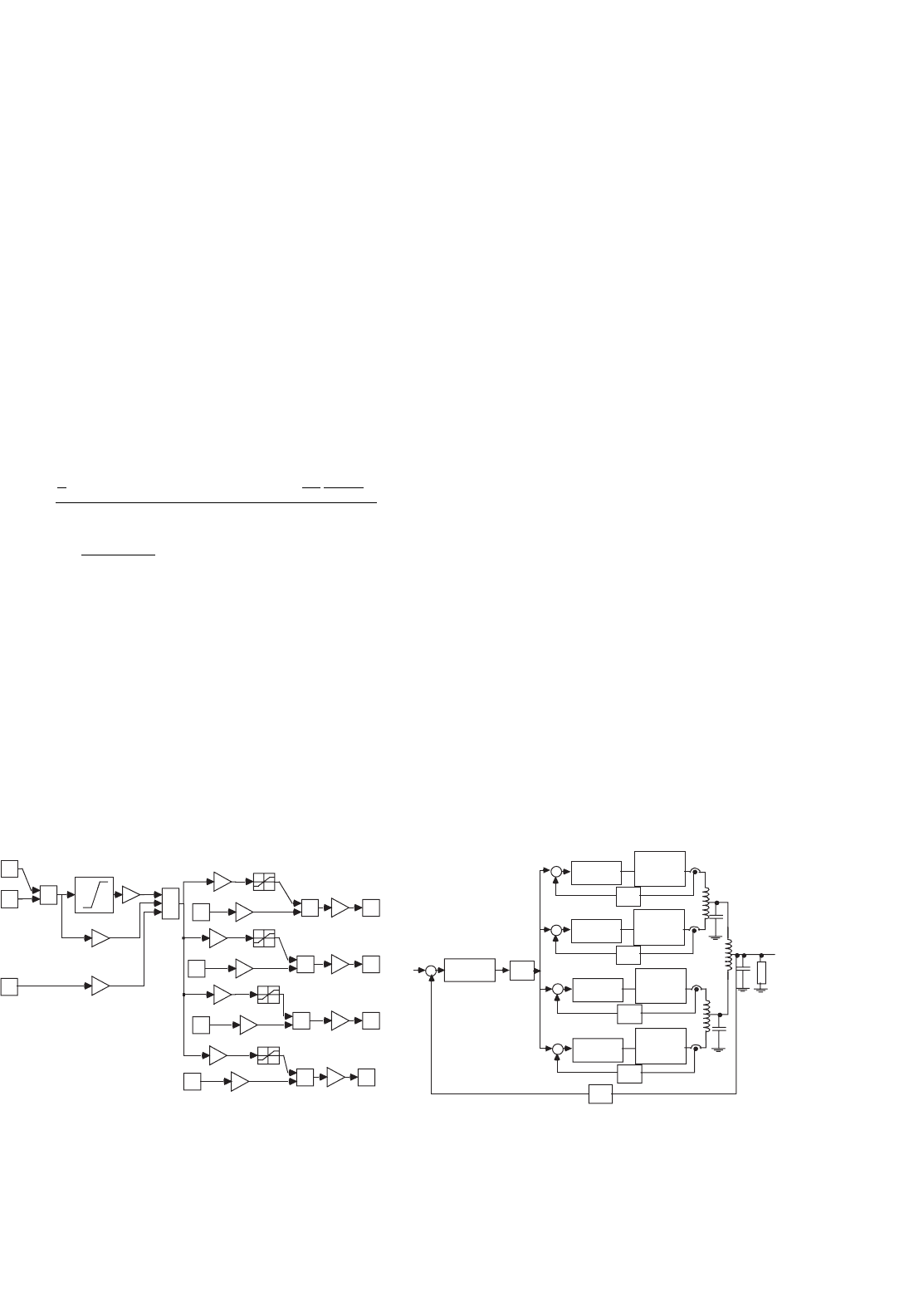
34 Control Methods for Switching Power Converters 969
If an inexpensive analog controller is desired, the successive
time derivatives of the reference voltage and the output current
of Eq. (34.124) can be neglected (furthermore, their calcula-
tion is noise prone). Nonzero errors on the first, second, and
third-order derivatives of the controlled variable will appear,
worsening the response speed. However, the steady-state error
is not affected.
To implement the four equations (34.124), the variables
v
c
2
, v
c
11
, v
c
12
, i
o
, i
l
5
, i
l
6
, i
l
1
, i
l
2
, i
l
3
, and i
l
4
must be measured.
Although this could be done easily, it is very convenient to
further simplify the practical controller, keeping its complexity
and cost at the level of linear controllers, while maintaining
the advantages of sliding mode. Therefore, the voltages v
c
11
and v
c
12
are assumed almost constant over one period of the
filter input current, and v
c
11
= v
c
12
= v
c
2
, meaning that i
l
5
=
i
l
6
= i
o
/2. With these assumptions, valid as the values of C
and C
2
are designed to provide an output voltage with very
low ripple, the new sliding-mode functions are
S
i
(e
x
i
, t)
n
≈
1
t
r
vc
2r
−vc
2
dt +k
1v
(v
c
2r
−v
c
2
) +
t
3
r
105
1
C
1
C
2
L
2
i
o
4
−
t
3
r
105C
1
L
2
C
2
i
ln
(34.125)
These approximations disregard only the high-frequency
content of v
c
11
, v
c
12
, i
l
5
, and i
l
6
, and do not affect the rec-
tifier steady-state response, but the step response will be a
little slower, although still much faster (150 ms, Fig. 34.39)
than that obtained with linear controllers (280 ms, Fig. 34.38).
Regardless of all the approximations, the low switching fre-
quency of the rectifier would not allow the elimination of
the dynamic errors. As a benefit of these approximations, the
sliding-mode controller (Fig. 34.36a) will need only an extra
current sensor (or a current observer) and an extra opera-
tional amplifier in comparison with linear controllers derived
K
u
K
i
K
i
K
i
K
i
+
+
−
i
ref
+
−
+
−
+
−
−
C
2
l
′
i
l
1
i
l
2
i
l
3
i
l
4
C
′
C
′
l
l
u
c
u
c
u
c
u
c
Load
l
l
l
′
PI current
controller
PI voltage
controller
PI current
controller
PI current
controller
PI current
controller
3 phase
half wave
rectifier
3 phase
half wave
rectifier
3 phase
half wave
rectifier
3 phase
half wave
rectifier
K
i
v
c2ref
v
c2ref
6
il4
4
S
ex4
5
il3
3
S
ex3
4
il2
2
S
ex2
3
il1
1
S
ex1
v
c2
Integrator
K-
k
1v
+
−
error
+
+
+
Sum
K-
k
Io
K-
k
1i
K-
kil1
+
−
Sum2
Sat_il1
K-
g1
K-
1_1/4
K-
kil2
+
−
Sum3
Sat_il2
K-
g2
K-
2_1/4
K-
kil3
+
−
Sum4
Sat_il3
K-
g3
K-
3_1/4
K-
kil4
+
−
Sum5
Sat_il4
K-
g4
K-
4_1/4
Io
1
2
1/s
7
(
a
)(
b
)
FIGURE 34.36 (a) Sliding-mode controller block diagram and (b) linear control hierarchy for the 12-pulse rectifier.
hereafter (which need four current sensors and six operational
amplifiers). Compared to the total cost of the 12-pulse recti-
fier plus output filter, the control hardware cost is negligible
in both the cases, even for medium-power applications.
34.3.5.6 Average Current-mode Control of the
12-pulse Rectifier
For comparison purposes a PI-based controller structure is
designed (Fig. 34.36b), taking into account, that small mis-
matches of the line voltages or of the trigger angles can
completely destroy the current share of the four paralleled
rectifiers, inspite of the current equalizing inductances (l and
l
). Output voltage control sensing only the output voltage
is, therefore, not feasible. Instead, the slow and fast manifold
approach is selected. For the fast manifold, four internal cur-
rent control loops guarantee the same dc current level in each
three-phase rectifier and limit the short-circuit currents. For
the output slow dynamics, an external cascaded output volt-
age control loop (Fig. 34.36b), measuring the voltage applied
to the load, is the minimum.
For a straightforward design, given the much slower dynam-
ics of the capacitor voltages compared to the input current,
the PI current controllers are calculated as shown in Exam-
ple 34.6, considering the capacitor voltage constant during a
switching period, and r
t
≈ 1 the intrinsic resistance of the
transformer windings, thyristor overlap, and inductor l. From
Eq. (34.59), T
z
= l/r
t
≈ 0.044 s. From, Eq. (34.62), with the
common assumptions, T
p
≈ 0.16k
I
s(p = 3). These values
guarantee a small overshoot (≈5%) and a current rise time of
approximately T/3.
To design the external output voltage control loop, each
current-controlled rectifier can be considered a voltage-
controlled current source i
L
1
(s)/4, since each half-wave rec-
tifier current response will be much faster than the filter
output voltage response. Therefore, in the equivalent circuit
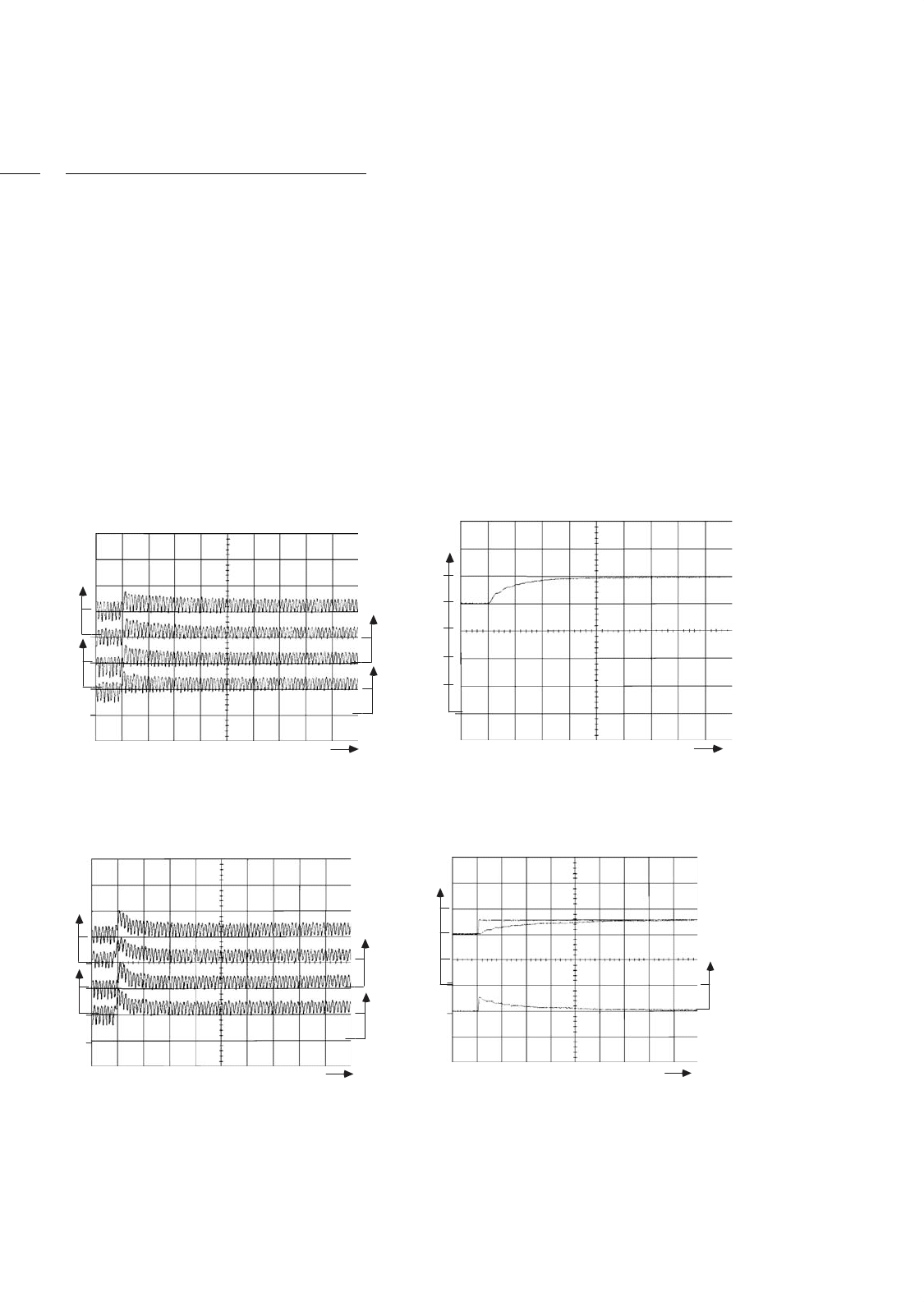
970 J. F. Silva and S. F. Pinto
of Fig. 34.35b, the current source i
L
1
(s) substitutes the input
inductor, yielding the transfer function v
c
2
(s)/i
L
1
(s):
V
c
2
(s)
i
L
1
(s)
=
R
o
C
2
C
1
L
2
R
o
s
3
+C
1
L
2
s
2
+(C
2
R
o
+C
1
R
o
)s +1
(34.126)
Given the real pole (p
1
=−6.7) and two complex poles
(p
2,3
=−6.65 ± j140.9) of Eq. (34.126), the PI voltage con-
troller zero (1/T
zv
= p
1
) can be chosen with a value equal to
the transfer function real pole. The integral gain T
pv
can be
determined using a root-locus analysis to determine the maxi-
mum gain, that still guarantees the stability of the closed-loop
controlled system. The critical gain for the PI was found to
be T
zv
/T
pv
≈ 0.4, then T
pv
> 0.37. The value T
pv
≈ 2 was
selected to obtain weak oscillations, together with almost no
overshoot.
The dynamic and steady-state responses of the output cur-
rents of the four rectifiers (i
l
1
, i
l
2
, i
l
3
, i
l
4
) and the output voltage
0
2A
0
2A
0
2A
i
l
2
i
l
3
0
2A
i
l
4
i
l
1
t (50 ms/div)
0
10
20
30
40
50
v
c
2
(V)
t (100 ms/div)
(a) (b)
CH1 = 2 V
CH2 = 2 V
CH3 = 2 V
CH4 = 2 V
window
50 ms/d
DCP
∗10 DCP∗10 DCP∗10 DCP∗10
DCP
∗10
CH1 = 10 V
17-DEC-1997
18-DEC-1997
H
o
w
window
100 ms/d
H
o
w
FIGURE 34.37 PI current controller performance: (a) i
l
1
, i
l
2
, i
l
3
, i
l
4
closed-loop currents and (b) open-loop output voltage V
c
2
.
CH2 = 2 V
CH3 = 2 V
CH4 = 2 V
window
50 ms/d
CH1 = 2 V
CH1 = 2 V
CH2 = 2 V
18-DEC-1997
H
o
w
window
100 ms/d
H
o
w
3 : Math
(1-2)
2
1
3
v
c
2
v
c
2
r
0
2A
i
l
2
0
2A
i
l
4
t (50 ms/div)
0
2A
0
2A
i
l
3
i
l
1
t (100 ms/div)
0
0
20
V
60V
40V
20V
(
a
)(
b
)
e
v
c
2
DC P ∗10 DC P ∗10 DC P ∗10 DC P ∗10
DC P
∗10 DC P ∗10
FIGURE 34.38 PI voltage controller performance: (a) i
l
1
, i
l
2
, i
l
3
, i
l
4
closed-loop currents and (b) closed output voltage V
c
2
and l
v
c
2
output voltage
error.
v
c
2
were analyzed using a step input from 2 to 2.5 A applied
at t = 1.1 s, for the currents, and from 40 to 50 V for the
v
c
2
voltage. The PI current controllers (Fig. 34.37) show good
sharing of the total current, a slight overshoot (ζ = 0.7) and
response time 6.6 ms (T/p).
The open-loop voltage v
c
2
presents a rise time of 0.38 s. The
PI voltage controller (Fig. 34.38) shows a response time of
0.4 s, no overshoot. The four three-phase half-wave rectifier
output currents (i
l
1
, i
l
2
, i
l
3
, and i
l
4
) present nearly the same
transient and steady-state values, with no very high current
peaks. These results validate the assumptions made in the PI
design.
The closed-loop performance of the fixed-frequency sliding-
mode controller (Fig. 34.39) shows that all the i
l
1
, i
l
2
, i
l
3
,
and i
l
4
currents are almost equal and have peak values only
slightly higher than those obtained with the PI linear con-
trollers. The output voltage presents a much faster response
time (150 ms) than the PI linear controllers, negligible or no
steady-state error, and no overshoot. From these waveforms
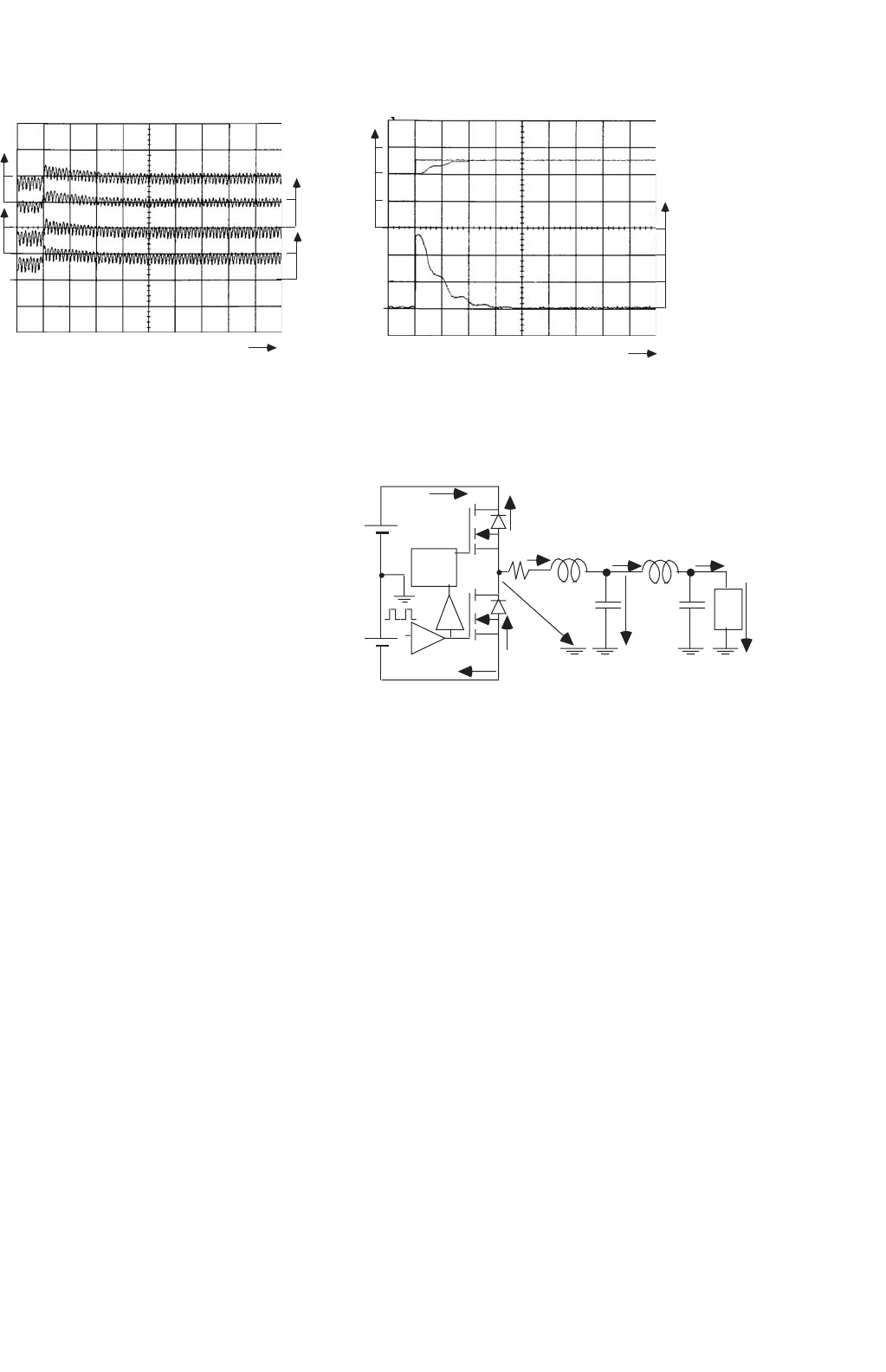
34 Control Methods for Switching Power Converters 971
CH2 = 2 V
CH3 = 2 V
CH4 = 2 V
window
50 ms/d
DC
DC
CH1 = 2 V
DC
P
∗10
P
∗10
P
∗10
DC
P
∗10
27-NOV-199715:17
27-NOV-199715:31
H
o
w
CH1 = 1 V
DC
P
∗10
CH2 = 20 V
DC
P
∗10
CH3 = 200 MV
DC
P
∗10
window
50ms / d
H
o
w
v
c
2
v
c
2
r
t (50 ms/div)
0
2A
0
2A
0
2A
i
l
2
i
l
3
0
2A
i
l
4
i
l
1
0
60V
40V
20V
0
e
v
c
2
t (50 ms/div)
4V
8V
12V
(a) (b)
FIGURE 34.39 Closed-loop constant-frequency sliding-mode controller performance: (a) i
l
1
, i
l
2
, i
l
3
, i
l
4
closed-loop currents and (b) closed output
voltage V
c
2
and e
v
c
2
output voltage error.
it can be concluded that the sliding-mode controller provides
a much more effective control of the rectifier, as the output
voltage response time is much lower than the obtained with PI
linear controllers, without significantly increasing the thyris-
tor currents, overshoots, or costs. Furthermore, sliding mode
is an elegant way to know the variables to be measured, and
to design all the controller and the modulator electronics.
E
XAMPLE 34.13 Sliding-mode control of pulse width
modulation audio power amplifiers
Linear audio power amplifiers can be astonishing, but
have efficiencies as low as 15–20% with speech or music
signals. To improve the efficiency of audio systems while
preserving the quality, PWM switching power amplifiers,
enabling the reduction of the power-supply cost, vol-
ume, and weight and compensating the efficiency loss
of modern loudspeakers, are needed. Moreover, PWM
amplifiers can provide a complete digital solution for
audio power processing.
For high-fidelity systems, PWM audio amplifiers must
present flat passbands of at least 16–20 kHz (±0.5 dB),
distortions less than 0.1% at the rated output power,
fast dynamic response, and signal-to-noise ratios above
90 dB. This requires fast power semiconductors (usually
metal-oxide semiconductor field effect transistor (MOS-
FET) transistors), capable of switching at frequencies
near 500 kHz, and fast nonlinear controllers to provide
the precise and timely control actions needed to accom-
plish the mentioned requirements and to eliminate the
phase delays in the LC output filter and loudspeakers.
A low-cost PWM audio power amplifier, able to
provide over 80 W to 8 loads (V
dd
= 50 V), can be
obtained using a half-bridge power inverter (switching at
f
PWM
≈ 450 kHz), coupled to an output filter for high-
frequency attenuation (Fig. 34.40). A low-sensitivity,
γ
v
PWM
-Vdd
Q1
Q2
Vdd
i
Q1
i
Q2
i
D1
i
D2
Level
Shifter
C
2
v
c
1
v
o
L
1
L
2
C
1
i
L
1
i
L
2
i
o
r
1
Speaker
-1
-G
Z
L
FIGURE 34.40 PWM audio amplifier with fourth-order Chebyshev
low-pass output filter and loudspeaker load.
doubly terminated passive ladder (double LC), low-pass
filter using fourth-order Chebyshev approximation
polynomials is selected, given its ability to meet, while
minimizing the number of inductors, the following
requirements: passband edge frequency 21 kHz, pass-
band ripple 0.5 dB, stopband edge frequency 300 kHz
and 90 dB minimum attenuation in the stopband (L
1
=
80 µH; L
2
= 85 µH; C
1
= 1.7 µF; C
2
= 820 nF;
R
2
= 8 ; r
1
= 0.47 ).
34.3.5.7 Modeling the PWM Audio Amplifier
The two half-bridge switches must always be in complemen-
tary states, to avoid power supply internal short-circuits. Their
state can be represented by the time-dependent variable γ,
which is γ = 1 when Q1 is on and Q2 is off, and is γ =−1
when Q1 is off and Q2 is on.
Neglecting switch delays, on state semiconductor voltage
drops, auxiliary networks, and supposing small dead times,
the half-bridge output voltage (v
PWM
)isv
PWM
= γV
dd
.
Considering the state variables and circuit components of

972 J. F. Silva and S. F. Pinto
Fig. 34.40, and modeling the loudspeaker load as a disturbance
represented by the current i
o
(ensuring robustness to the fre-
quency dependent impedance of the speaker), the switched
state-space model of the PWM audio amplifier is
d
dt
i
L
1
v
c
1
i
L
2
v
o
=
−r
1
/L
1
−1/L
1
00
1/C
1
0 −1/C
1
0
01/L
2
0 −1/L
2
001/C
2
0
i
L
1
v
c
1
i
L
2
v
o
+
1/L
1
0
00
00
0 −1/C
2
γV
dd
i
o
(34.127)
This model will be used to define the output voltage v
o
controller.
34.3.5.8 Sliding-mode Control of the PWM Audio
Amplifier
The filter output voltage v
o
, divided by the amplifier gain
(1/k
v
), must follow a reference v
o
r
. Defining the output error as
e
v
o
= v
o
r
−k
v
v
o
, and also using its time derivatives (e
θ
, e
γ
, e
β
)
as a new state vector e =[e
v
o
, e
θ
, e
γ
, e
β
]
T
, the system equa-
tions, in the phase canonical (or controllability) form, can be
written in the form
d
dt
[e
v
o
, e
θ
, e
γ
, e
β
]
T
=[e
θ
, e
γ
, e
β
, −f (e
v
o
, e
θ
, e
γ
, e
β
) +p
e
(t)
−γV
dd
/C
1
L
1
C
2
L
2
]
T
(34.128)
Sliding-mode control of the output voltage will enable a
robust and reduced-order dynamics, independent of semicon-
ductors, power supply, filter, and load parameters. According
to Eqs. (34.91) and (34.128), the sliding surface is
S(e
v
o
, e
θ
, e
γ
, e
β
, t) = e
v
o
+k
θ
e
θ
+k
γ
e
γ
+k
β
e
β
= v
o
r
−k
v
v
o
+k
θ
d
v
o
r
−k
v
v
o
dt
+k
γ
d
dt
&
d
v
o
r
−k
v
v
o
dt
'
+k
β
d
dt
d
dt
&
d
v
o
r
−k
v
v
o
dt
'
= 0
(34.129)
In sliding mode, Eq. (34.129) confirms the amplifier gain
(v
o
/v
o
r
= 1/k
v
). To obtain a stable system and the small-
est possible response time t
r
, a pole placement according to
a third-order Bessel polynomial is used. Taking t
r
inversely
proportional to a frequency just below the lowest cutoff
frequency (ω
1
) of the double LC filter (t
r
≈ 2.8/ω
1
≈
2.8/(2π ×21 kHz)≈ 20 µs) and using Eq. (34.88) with m = 3,
the characteristic polynomial Eq. (34.130), verifying the
Routh–Hurwitz criterion is obtained.
S(e, s) = 1 + st
r
+
6
15
(
st
r
)
2
+
1
15
(
st
r
)
3
(34.130)
From Eq. (34.97) the switching law for the control input at
time t
k
, γ(t
k
), must be
γ(t
k
) = sgn
(
S(e, t
k
) +ε sgn
S(e, t
k−1
)
)
(34.131)
To ensure reaching and existence conditions, the power sup-
ply voltage V
dd
must be greater than the maximum required
mean value of the output voltage in a switching period
V
dd
>
(
v
PWMmax
)
. The sliding-mode controller (Fig. 34.41) is
obtained from Eqs. (34.129–34.131) with k
θ
= t
r
, k
γ
= 6t
2
r
/15,
k
β
= t
3
r
/15. The derivatives can be approximated by the block
diagram of Fig. 34.41b, were h is the oversampling period.
Fig. 34.42a shows the v
PWM
, v
o
r
, v
o
/10, and the error
10 × (v
o
r
− v
o
/10) waveforms for a 20 kHz sine input. The
overall behavior is much better than the obtained with the
sigma-delta controllers (Figs. 34.43 and 34.44) explained below
for comparison purposes. There is no 0.5 dB loss or phase
delay over the entire audio band; the Chebyshev filter behaves
as a maximally flat filter, with higher stopband attenuation.
Fig. 34.42b shows v
PWM
, v
o
r
, and 10 × (v
o
r
− v
o
/10) with a
1 kHz square input. There is almost no steady-state error and
almost no overshoot on the speaker voltage v
o
, attesting to the
speed of response (t ≈ 20 µs as designed, since, in contrast to
Example 34.12, no derivatives were neglected). The stability,
the system order reduction, and the sliding-mode controller
usefulness for the PWM audio amplifier are also shown.
34.3.5.9 Sigma Delta Controlled PWM Audio
Amplifier
Assume now the fourth-order Chebyshev low-pass filter, as
an ideal filter removing the high-frequency content of the
v
PWM
voltage. Then, the v
PWM
voltage can be considered as the
amplifier output. However, the discontinuous voltage v
PWM
=
γV
dd
is not a state variable and cannot follow the almost con-
tinuous reference v
PWM
r
. The new error variable e
vPWM
=
v
PWM
r
− k
v
γV
dd
is always far from the zero value. Given
this nonzero error, the approach outlined in Section 34.3.4
can be used. The switching law remains Eq. (34.131), but the
new control law Eq. (34.132) is
S(e
vPWM
, t) = κ
(v
PWM
r
−k
v
γV
dd
)dt = 0 (34.132)
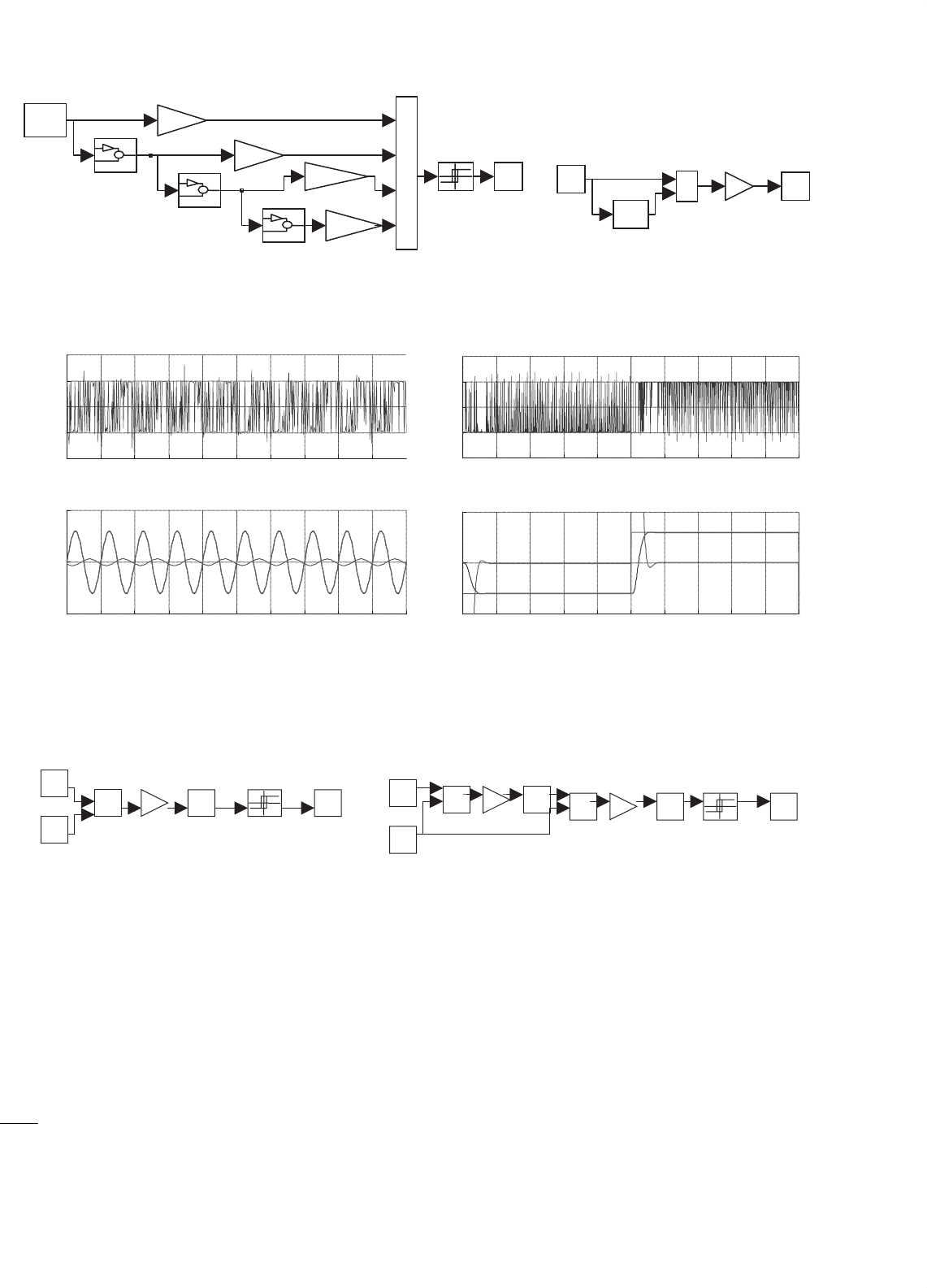
34 Control Methods for Switching Power Converters 973
1
vor-kv vo
(e(t)-e(t-1))tr/h
(e'(t)-e'(t-1))tr/h
Sum5
1
1
6/15
kgama
(e''(t)-e''(t-1))tr/h
1/15
kbeta
1
kteta
Hysterisis
epsilon
comparator
1
gama
1
in_1
1
out_1
-K-
tr/h
+
−
Sum6
1/ z
Unit Delay
(a) (b)
FIGURE 34.41 (a) Sliding-mode controller for the PWM audio amplifier and (b) implementation of the derivative blocks.
×10
−4
0 0.5 1 1.5 2 2.5 3 3.5 4 4.5 5
−100
−50
0
50
100
t[s]
vPWM [V]
×10
−4
t[s]
(a) (b)
1}vi, 2}vo/10, 3}10*(vi-vo/10) [V]
0 0.5 1 1.5 2 2.5 3 3.5 4 4.5 5
−5
0
5
1
3
2
×10
−3
0
0.1 0.2 0.3 0.4 0.5 0.6 0.7 0.8 0.9 1
−100
−50
0
50
100
t[s]
vPWM [V]
×10
−3
t[s]
1}vi, 2}vo/10, 3}10*(vi-vo/10) [V]
0 0.1 0.2 0.3 0.4 0.5 0.6 0.7 0.8 0.9 1
−5
0
5
1
3
2
FIGURE 34.42 Sliding-mode controlled audio power amplifier performance (upper graphs show v
PWM
, lower graph traces 1 show v
o
r
(v
o
r
≡ v
i
),
lower graph traces 2 show v
o
/10, and lower graph traces 3 show 10×(v
o
r
− v
o
/10)): (a) response to a 20 kHz sine input, at 55 W output power and
(b) response to 1 kHz square wave input, at 100 W output power.
+
−
Sum4
(
a
)(
b
)
1
vpwmr
2
kv vpwm
1/s
integral Hysteresis
epsilon
comparator
1
gama
1
vpwmr
+
−
+
−
1/s
int
K-
din
K-
K-
fPWM
gain
1/s
integral Hysteresis
epsilon
comparator
1
gam
a
2
vpwm
κ
+
1
−
+
2
−
FIGURE 34.43 (a) First-order sigma delta modulator and (b) second-order sigma delta modulator.
The κ parameter is calculated to impose the maxi-
mum switching frequency f
PWM
. Since κ
1/2f
PWM
0
(v
PWM
rmax
+
k
v
V
dd
)dt = 2ε, we obtain
f
PWM
= κ(v
PWM
rmax
+k
v
V
dd
)/(4ε) (34.133)
Assuming that v
PWM
r
is nearly constant over the switching
period 1/f
PWM
, Eq. (34.132) confirms the amplifier gain, since
v
PWM
= v
PWM
r
/k
v
.
Practical implementation of this control strategy can be
done using an integrator with gain κ (κ≈1800), and a com-
parator with hysteresis ε (ε ≈ 6 mV), Fig. 34.43a. Such
an arrangement is called a first-order sigma-delta ()
modulator.
Fig. 34.44a shows the v
PWM
, v
o
r
, and v
o
/10 waveforms for a
20 kHz sine input. The overall behavior is as expected, because
the practical filter and loudspeaker are not ideal, but notice the
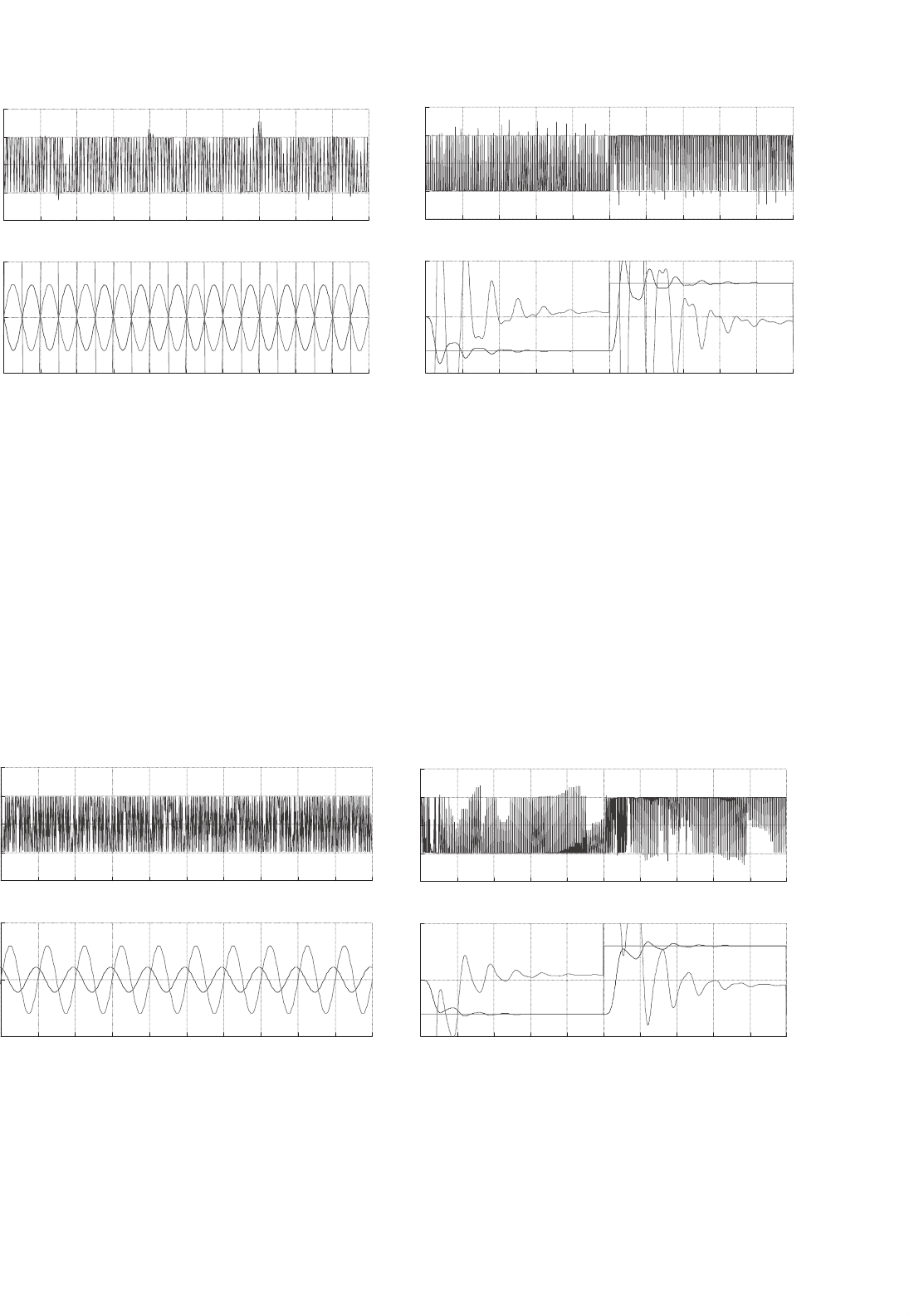
974 J. F. Silva and S. F. Pinto
0 0.5 1 1.5 2 2.5 3 3.5 4 4.5
t[s]
5
×10
−4
−100
−50
0
50
100
vPWM [V]
0 0.5 1 1.5 2 2.5 3 3.5 4 4.5 5
×10
−4
−5
0
5
t[s]
(a) (b)
1}vi, 2}vo/10, 3}10*(vi-vo/10) [V]
1
3
2
0 0.1 0.2 0.3 0.4 0.5 0.6 0.7 0.8 0.9 1
×10
−3
−100
−50
0
50
100
t[s]
vPWM [V]
0 0.1 0.2 0.3 0.4 0.5 0.6 0.7 0.8 0.9 1
×10
−3
−5
0
5
t[s]
1}vi, 2}vo/10, 3}10*(vi-vo/10) [V]
1
3
2
FIGURE 34.44 First-order sigma-delta audio amplifier performance (upper graphs show v
PWM
, lower graphs trace 1 show v
o
r
≡ v
i
, lower graphs
trace 2 shows v
o
/10, and lower graphs trace 3 show 10×(v
o
r
− v
o
/10)): (a) response to a 20 kHz sine input, at 55 W output power and (b) response
to 1 kHz square wave input, at 100 W output power.
0.5 dB loss and phase delay of the speaker voltage v
o
, mainly
due to the output filter and speaker inductance. In Fig. 34.44b,
the v
PWM
, v
o
r
, v
o
/10, and error 10 ×(v
o
r
−v
o
/10) for a 1 kHz
square input are shown. Note the oscillations and steady-state
error of the speaker voltage v
o
, due to the filter dynamics and
double termination.
A second-order sigma-delta modulator is a better compro-
mise between circuit complexity and signal-to-quantization
0 0.5 1 1.5 2 2.5 3 3.5 4 4.5 5
×10
−4
t[s]
0 0.5 1 1.5 2 2.5 3 3.5 4 4.5 5
×10
−4
t[s]
(a) (b)
1
3
2
0 0.1 0.2 0.3 0.4 0.5 0.6 0.7 0.8 0.9 1
×10
−3
−100
−50
0
50
100
t[s]
vPWM [V]
0 0.1 0.2 0.3 0.4 0.5 0.6 0.7 0.8 0.9 1
×10
−3
−5
0
5
t[s]
1}vi, 2}vo/10, 3}10*(vi-vo/10) [V]
−100
−50
0
50
100
vPWM [V]
−5
0
5
1}vi, 2}vo/10, 3}10*(vi-vo/10) [V]
1
3
2
FIGURE 34.45 Second-order sigma-delta audio amplifier performance (upper graphs show v
PWM
, lower graphs trace 1 show v
o
r
≡v
i
, lower graphs
trace 2 show v
o
/10, and lower graphs trace 3 show 10×(v
o
r
− v
o
/10)): (a) response to 1 kHz square wave input, at 100 W output power and
(b) response to a 20 kHz sine input, at 55 W output power.
noise ratio. As the switching frequency of the two power
MOSFET (Fig. 34.40) cannot be further increased, the second-
order structure named “cascaded integrators with feedback”
(Fig. 34.43b) was selected, and designed to eliminate the step
response overshoot found in Fig. 34.44b.
Fig. 34.45a, for 1 kHz square input, shows much less over-
shoot and oscillations than Fig. 34.44b. However, the v
PWM
,
v
o
r
, and v
o
/10 waveforms, for a 20 kHz sine input presented
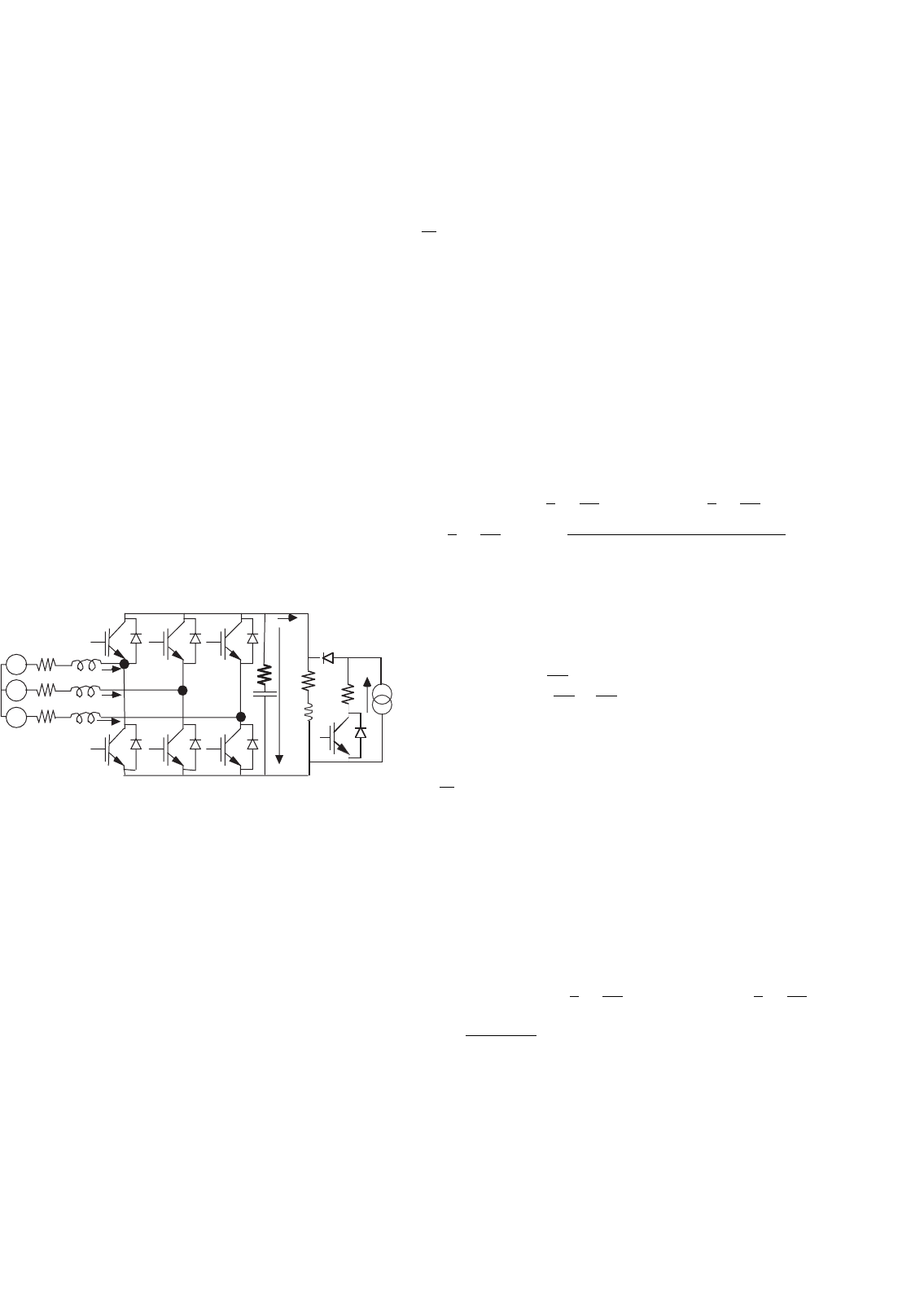
34 Control Methods for Switching Power Converters 975
in Fig. 34.45b, show increased output voltage loss, com-
pared to the first-order sigma-delta modulator, since the
second-order modulator was designed to eliminate the v
o
output voltage ringing (therefore reducing the amplifier band-
width). The obtained performances with these and other
sigma-delta structures are inferior to the sliding-mode perfor-
mances (Fig. 34.42). Sliding mode brings definite advantages
as the system order is reduced, flatter passbands are obtained,
power supply rejection ratio is increased, and the nonlinear
effects, together with the frequency-dependent phase delays,
are cancelled out.
E
XAMPLE 34.14 Sliding-mode control of near unity
power factor PWM rectifiers
Boost-type voltage-sourced three-phase rectifiers
(Fig. 34.46) are multiple-input multiple-output (MIMO)
systems capable of bidirectional power flow, near unity
power factor operation, and almost sinusoidal input cur-
rents, and can behave as ac/dc power supplies or power
factor compensators.
The fast power semiconductors used (usually MOS-
FETs or IGBTs) can switch at frequencies much higher
than the mains frequency, enabling the voltage controller
to provide an output voltage with fast dynamic response.
Su1
C
o
v
RL
R
L
~
R
L
Su2
S12S11
Su3
S13
o
i
v
1
v
2
v
3
i
2
i
3
I
a
R
1
R
2
~
~
Rc
Sa
i
1
FIGURE 34.46 Voltage-sourced PWM rectifier with IGBTs and test
load.
34.3.5.10 Modeling the PWM Boost Rectifier
Neglecting switch delays and dead times, the states of the
switches of the kth inverter leg (Fig. 34.46) can be represented
by the time-dependent nonlinear variables γ
k
, defined as
γ
k
=
1> if Su
k
is on and Sl
k
is off
0> if Su
k
is off and Sl
k
is on
(34.134)
Consider the displayed variables of the circuit (Fig. 34.46),
where L is the value of the boost inductors, R their resistance,
C the value of the output capacitor, and R
c
its equivalent series
resistance (ESR). Neglecting semiconductor voltage drops,
leakage currents, and auxiliary networks, the application of
Kirchhoff laws (taking the load current i
o
as a time-dependent
perturbation) yields the following switched state-space model
of the boost rectifier:
d
dt
i
1
i
2
i
3
v
o
=
−R/L 00−2γ
1
+γ
2
+γ
3
/3L
0 −R/L 0 −2γ
2
+γ
3
+γ
1
/3L
00−R/L −2γ
3
+γ
1
+γ
2
/3L
A
41
A
42
A
43
A
44
i
1
i
2
i
3
v
o
+
1/L 0000
01/L 000
001/L 00
γ
1
R
c
/L γ
2
R
c
/L γ
3
R
c
/L −1/C −R
c
v
1
v
2
v
3
i
o
di
o
/dt
(34.135)
where A
41
= γ
1
1
C
−
RR
c
L
; A
42
= γ
2
1
C
−
RR
c
L
; A
43
=
γ
3
1
C
−
RR
c
L
; A
44
=
−2R
c
(
γ
1
(
γ
1
−γ
2
)
+γ
2
(
γ
2
−γ
3
)
+γ
3
(
γ
3
−γ
1
))
3L
.
Since the input voltage sources have no neutral connection,
the preceding model can be simplified, eliminating one equa-
tion. Using the relationship (34.136) between the fixed frames
x
1, 2, 3
and x
α,β
, in Eq. (34.135), the state-space model (34.137),
in the α, β frame, is obtained.
x
1
x
2
=
√
2/3 0
−
√
1/6
√
1/2
x
α
x
β
(34.136)
d
dt
i
α
i
β
v
o
=
−R/L ω −γ
α
/L
0 −R/L −γ
β
/L
A
α
31
A
α
32
A
α
33
i
α
i
β
v
o
+
1/L 000
01/L 00
γ
α
R
c
/L γ
β
R
c
/L −1/C −R
c
v
α
v
β
i
o
di
o
/dt
(34.137)
where A
α
31
= γ
α
1
C
−
RR
c
L
; A
α
32
= γ
β
1
C
−
RR
c
L
;
A
α
33
=
−R
c
γ
2
α
+γ
2
β
L
.
34.3.5.11 Sliding-mode Control of the PWM Rectifier
The model (34.137) is nonlinear and time-variant. Applying
the Park transformation (34.138), using a frequency ω rotating

976 J. F. Silva and S. F. Pinto
reference frame synchronized with the mains (with the q com-
ponent of the supply voltages equal to zero), the nonlinear,
time-invariant model (34.139) is written:
i
a
i
b
=
cos(ωt ) −sin(ωt)
sin(ωt) cos(ωt )
i
d
i
q
(34.138)
d
dt
i
d
i
q
v
o
=
−R/L ω −γ
d
/L
−ω −R/L −γ
q
/L
A
d
31
A
d
32
A
d
33
i
d
i
q
v
o
+
1/L 000
01/L 00
γ
d
R
c
/L γ
q
R
c
/L −1/C −R
c
v
d
v
q
i
o
di
o
dt
(34.139)
where A
d
31
= γ
d
1
C
−
RR
c
L
; A
d
32
= γ
q
1
C
−
RR
c
L
;
A
d
33
=
−R
c
γ
2
d
+γ
2
q
L
.
This state-space model can be used to obtain the feedback
controllers for the PWM boost rectifier. Considering the out-
put voltage v
o
and the i
q
current as the controlled outputs and
γ
d
, γ
q
the control inputs (MIMO system), the input–output
linearization of Eq. (34.72) gives the state-space equations in
the controllability canonical form (34.140):
di
q
dt
=−ωi
d
−
R
L
i
q
−
γ
q
L
v
o
+
1
L
v
q
dv
o
dt
= θ
dθ
dt
=
R +R
c
γ
2
d
+γ
2
q
L
θ −
γ
2
d
+γ
2
q
LC
v
o
+
γ
d
v
d
+γ
q
v
q
LC
−
Ri
o
LC
−
1
C
+
RR
c
L
di
o
dt
(34.140)
+ω
1
C
−
RR
c
L
γ
d
i
q
−γ
q
i
d
−R
c
d
2
i
o
dt
2
where
θ =
1
C
−
RR
c
L
γ
d
i
d
+γ
q
i
q
−
R
c
γ
2
d
+γ
2
q
L
v
o
+
R
c
L
γ
d
v
d
+γ
q
v
q
−
i
o
C
−R
c
di
o
dt
.
Using the rectifier overall power balance (from Tellegen’s
theorem, the converter is conservative, i.e. the power deliv-
ered to the load or dissipated in the converter intrinsic devices
equals the input power), and neglecting the switching and
output capacitor losses, v
d
i
d
+ v
q
i
q
= v
o
i
o
+ Ri
2
d
. Suppos-
ing unity power factor (i
qr
≈ 0), and the output v
o
at steady
state, γ
d
i
d
+ γ
q
i
q
≈ i
o
, v
d
=
√
3V
RMS
, v
q
= 0, γ
q
≈ v
q
/v
o
,
γ
d
≈ (v
d
−Ri
d
)/v
o
. Then, from Eqs. (34.140) and (34.91), the
following two sliding surfaces can be derived:
S
q
(e
i
q
, t) = k
e
iq
(i
qr
−i
q
) = 0 (34.141)
S
d
(e
v
o
, e
θ
, t)≈
β
−1
(v
o
r
−v
o
)+
dv
o
r
dt
+
1
C
i
o
+R
c
di
o
dt
×
LC
L −CRR
c
v
o
√
3V
RMS
−Ri
d
−i
d
=i
d
r
−i
d
=0
(34.142)
where β
−1
is the time constant of the desired first-order
response of output voltage v
o
(β T > 0). For the syn-
thesis of the closed-loop control system, notice that the terms
of Eq. (34.142) inside the square brackets can be assumed as
the i
d
reference current i
d
r
. Furthermore, from Eqs. (34.141)
and (34.142) it is seen that the current control loops for i
d
and
i
q
are needed. Considering Eqs. (34.138) and (34.136), the two
sliding surfaces can be written
S
α
(e
i
α
, t) = i
α
r
−i
α
= 0 (34.143)
S
β
(e
i
β
, t) = i
β
r
−i
β
= 0 (34.144)
The switching laws relating the sliding surfaces (34.143,
34.144) with the switching variables γ
k
are
If S
αβ
(e
i
αβ
,t) >εthen i
αβ
r
> i
αβ
hence choose γ
k
to
increase the i
αβ
current
If S
αβ
(e
i
αβ
,t) < −ε then i
αβ
r
< i
αβ
hence choose γ
k
to
decrease the i
αβ
current
(34.145)
The practical implementation of this switching strategy
could be accomplished using three independent two-level hys-
teresis comparators. However, this might introduce limit cycles
as only two line currents are independent. Therefore, the con-
trol laws (34.143, 34.144) can be implemented using the block
diagram of Fig. 34.47a, with d, q/α, β (from Eq. (34.138)) and
1,2,3/α,β (from Eq. (34.136)) transformations and two three-
level hysteretic comparators with equivalent hysteresis ε and
ρ to limit the maximum switching frequency. A limiter is
included to bound the i
d
reference current to i
dmax
, keeping
the input line currents within a safe value. This helps to elimi-
nate the nonminimum-phase behavior (outside sliding mode)
when large transients are present, while providing short-circuit
proof operation.
